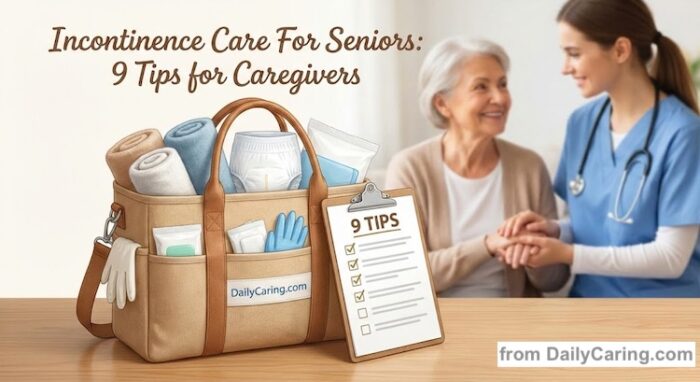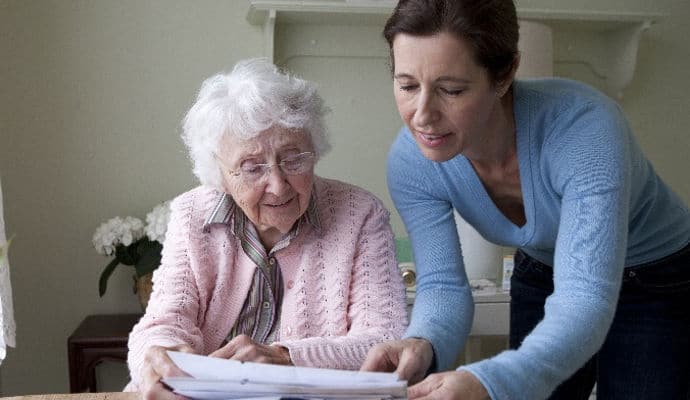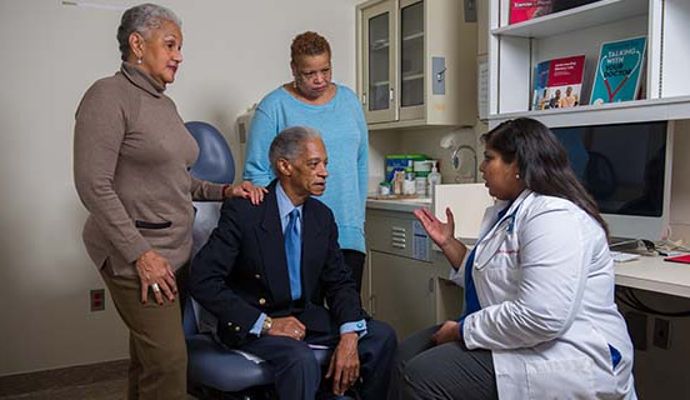For many caregivers, managing a loved one’s incontinence is a source of daily stress and anxiety. The worry about skin breakdown, accidents, and the emotional toll on your family member can feel overwhelming. But what if you could replace that stress associated with incontinence care for seniors with a sense of control and confidence?
It begins with moving beyond mere containment to a holistic approach that focuses on health, dignity, and ease. Discover these nine practical tips that will help you provide better care, prevent complications, and restore a sense of calm to your days.

50% of Seniors Experience Incontinence
Studies have shown that about 50% of older adults have some form of incontinence. For many, it can be uncomfortable, messy, or embarrassing.
It can also be a significant source of stress for caregivers who try to minimize accidents and clean up the messes.
Think of incontinence not as a personal failure or a taboo subject, but as a medical symptom to be managed, just like you would manage blood pressure. Effective management is the gateway to reducing anxiety and getting back to enjoying life together. – Joan Lundun
To reduce stress and mess for both seniors and caregivers, we share nine helpful tips for managing incontinence in seniors.
1. Talk With a Doctor
Despite popular misconceptions, incontinence isn’t a regular part of aging. Common and treatable medical conditions often cause incontinence in aging adults.
If you notice ongoing signs of incontinence, take your loved one to the doctor for a thorough examination to determine whether they have an infection (such as a UTI) or another treatable condition.
2. Watch Out for Certain Foods and Drinks
Did you know that many common foods and drinks can trigger incontinence? Many of these triggers and bladder irritants are things that we’d never think of.
Here’s Mayo Clinic’s list of items that may contribute to incontinence:
- Too little fluid
- Too much fluid
- Coffee, tea, and carbonated drinks – with and without caffeine
- Certain acidic fruits, like oranges, grapefruits, lemons, and limes, and acidic fruit juices
- Spicy foods
- Alcohol
- Chocolate
- Tomatoes and tomato-based products – even ketchup
- Sugar, honey, and artificial sweeteners
To manage one’s incontinence, encourage an older adult to drink an adequate amount of fluids and minimize “trigger foods and drinks”.
Not everyone’s bladder will be sensitive to the same trigger foods or drinks.
If many of these items are part of your loved one’s regular diet, try removing or reducing one item at a time to try to improve their incontinence symptoms.
3. Stick to a Bathroom Schedule
A regular daily routine is helpful for older adults, especially those with Alzheimer’s or dementia. It’s also a good way to get their bodily functions accustomed to going at certain times.
Create a bathroom schedule by asking your older adult to use the toilet at regular intervals (even to “try”).
You could start by asking them to go every 1 or 2 hours. Experiment to find the timing that works best for their body – and then stick to it.
Soon, your older adult’s body will adjust to the schedule, reducing the risk of accidents.
4. Waterproof the Mattress, Sofa, and Chairs
Cleaning up is a big issue in incontinence care. Accidents leave a smelly mess on your older adult’s clothes as well as on furniture.
Clothes and bedding can be thrown into the washing machine. However, it’s understandably stressful and tiring to try to clean and deodorize something that’s not easily cleanable, such as a mattress or easy chair.
To prevent the problem and make cleanup easier, waterproof the furniture that your older adult uses most often.
Leaks are common, so it typically takes multiple layers to fully protect these surfaces. Try these top tips for waterproofing their bed and pillows. Did you know there are products available to help mitigate bedtime dribbles? We found an interesting product called Peelaways, a disposable bed sheet that is waterproof. Exciting product!
And for couches and easy chairs, spray with a fabric protector and then layer with waterproof sofa covers, seat protectors, or extra large absorbent bed pads.
VIDEO: Incontinence Care for Seniors – 9 Tips
5. Use Humor to Diffuse Anxiety and Embarrassment
The shame and embarrassment that incontinence can cause are stressful for both your older adult and you.
Treating it as a regular part of life helps to ease the tension. Reassure them that it’s ok and take a matter-of-fact approach to cleanup.
You could say, “Don’t worry, it happens to a lot of people. Let me help you clean up and change into some clean, comfy clothes.”
After an accident, gentle humor also helps to diffuse a tense situation. While still being respectful, find ways to see the silly side of things and encourage laughter.
For example, you could say with a smile, “Now we’ve got the perfect excuse to change into your blue pants. Those are one of your favorite pairs!”
6. Have an Incontinence Care Kit on Hand
Incontinence doesn’t mean that you and your older adult can’t leave the house.
Pack a tote bag with clean-up essentials so you’ll always be prepared in case of an accident.
Include extra incontinence briefs or pads, personal cleansing wipes, and a change of clothes and socks.
7. Choose Clothing that’s Easy to Change and Launder
To reduce accidents and make incontinence care easier, it might be time for a wardrobe update.
Clothing that’s tough to get on and off could be causing accidents. They also make it difficult to get cleaned up afterward.
For example, pants with an elastic waistband are quicker and easier to pull down than pants with a regular zip fly. That will help your older adult reach the toilet quickly and hopefully prevent an accident.
Additionally, elastic waistbands are much easier to manage when helping someone get undressed or dressed.
Many clothing items found at major retail stores will work. Try to avoid clothes with multiple fastenings (such as button-fly pants), difficult clasps, tricky zippers, or tight openings.
And depending on your older adult’s needs, adaptive clothing that’s specifically designed for easy access might work even better. As a bonus, many of today’s adaptive clothing designs are stylish and discreet, and easy to put on and take off.
If your older adult has Alzheimer’s or dementia and they tend to take off their clothes or incontinence briefs inappropriately, try a back-zip jumpsuit like these from Silvert’s or these from Buck & Buck.
They appear to be separate top and bottom pieces, but are actually a one-piece jumpsuit that is difficult to take off without assistance.
8. Get Rid of Lingering Odors
Another thing that drives caregivers crazy about incontinence is the lingering odor.
Many experienced caregivers swear by OdoBan to disinfect and eliminate odor, or an air purifier to help rooms smell fresh.
9. Get Help From Professionals
For various reasons, a caregiver may not be able to provide incontinence care independently or in a home setting.
In that case, consider hiring an in-home caregiver to help with personal hygiene and toileting. Alternatively, consider relocating them to a care community that offers a higher level of care.
Recommended for you:
- 3 Top Benefits of a Daily Routine for Seniors
- 7 Tips to Get Someone with Dementia to Shower
- 7 Steps for Hiring a Caregiver for In-Home Help
This article contains affiliate links. We never link to products or services for the sole purpose of making a commission. Recommendations are based on our honest opinions. For more information, see How We Make Money.
About the Author

Connie is the founder of DailyCaring.com and was a hands-on caregiver for her grandmother for 20 years. (Grandma made it to 101 years old!) She knows how challenging, overwhelming, and all-consuming caring for an older adult can be. She also understands the importance of support, especially in the form of practical solutions, valuable resources, and self-care tips.













Odoban works great for us. and it can be used in the washer with throw rugs and suck as well. We have those next to the bed for accident catchers, helps save the wood floors. it can also be poured in commodes and sink drains , and it does not need alot.
If you are taking care of a male you can use Quick Wraps around their male anatomy. It hold up to 17 ounces of fluid. Can be used inside underwear, disposable briefs or tabbed briefs. Easily changed without having to change underwear or disposable briefs unless they are soiled. Prevents MASDs from developing .
Be aware that spray on chemicals to waterproof or resist stains on furniture can be extremely toxic to at least 1/3 of the population who are sensitive. On my couch I use re-useable waterproof pet pads, then a beach towel, then a disposable pad on top. No moisture has made it to the couch yet.
That’s an excellent point, thank you for bringing it up and for sharing your solution!
My 93 year old mother has stage 4 Alzheimers and lives on her own. She is mildly incontinent but refuses to admit or recognise her problem. Mother will not be persuaded to wear incontinence underwear because of her stubborn attitude and indifference to her condition. Her bathroom and outlying areas are evidence of her incontinence, but mother is gloriously ignorant.
It sounds like your mother’s Alzheimer’s may be too advanced to allow her to live on her own. She may not have the ability to care for herself any longer.
These articles may be helpful:
– 7 Tips for Managing Alzheimer’s and Incontinence https://dailycaring.com/northshore-7-smart-solutions-how-to-manage-incontinence-with-alzheimers/
– 7 Steps for Hiring a Caregiver for In-Home Help https://dailycaring.com/7-steps-for-hiring-a-caregiver-for-in-home-help/
– 3 Tips to Choose Between Assisted Living vs In-Home Care https://dailycaring.com/3-tips-to-help-you-choose-between-assisted-living-vs-in-home-care/
– When to Move to Assisted Living? Advice From a Social Worker https://dailycaring.com/when-should-a-senior-move-to-assisted-living-get-advice-from-a-social-worker/
– Memory Care: Assisted Living for Alzheimer’s and Dementia https://dailycaring.com/alzheimers-dementia-memory-care-basics/
How about incontinence from past surgery? Mom had colon cancer many years ago that has now left her with that issue as well as bladder incontinence. It is not consistent or every day and she is very independent other than that. She is living in the independent section of a senior facility, and they all are horrified to think they have to move to assisted section. (also the switch will be $$$). Any tricks or creative ways to deal with that??
Since this was caused by surgery, your mom could speak with her doctor to find out if there are tips they have to improve the situation. Or, she may want to start using preventive measures like wearing an incontinence brief. Many of the newer styles are thin and discreet.
I found a product called Kids N Pets at my local store. The enzymes seem to eliminate urine and its odor effectively. I also bought a UV flashlight to see the spots that need treating and cleaned up an old, old pet stain in the carpet, as well as fresh spots.
Great suggestions, thanks for sharing!
I’m caring for my 87 year old mother who is a bit incontinent and has worn “disposable underpants” for a few years now (that’s what she prefers to call them). I decided to install a bidet attachment onto her toilet. It helps tremendously in keeping her cleaner and she’s still able to use it herself. There are tons of bidet attachment options, many under $100 (we love our Hello Tushy, but there are other good brands out there as well – Luxe, Omigo) and then there are bidet toilet SEAT options that go well into the hundreds. I was so happy with mom’s, I got one for my bathroom too!
It’s wonderful that the bidet is working well for her (and you)! Many people love them.
For those who are interested, we’ve got some bidet suggestions here – Bidets for Seniors Improve Hygiene and Independence https://dailycaring.com/bidets-for-seniors-improve-hygiene-and-independence/
I have been using OdoBan for years. You can find the 32oz for less than $4.00 and the gallon size for less than $10.00 in stores. However, there are more options via online at Walmart.com.
Thanks for sharing! It’s great that OdoBan has been working well for you.